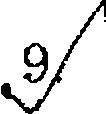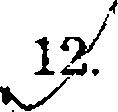University of Delhi 2009-2nd Year B.Sc Computer Science (Hons)/ III sem /s / NS -204-PROBABILITY - Question Paper
This question paper contains 4+2 printed pagesj
Your Roll No.l.F.....................1978
B.Sc. (Hons.) Computer Science G II Semester/NS
Paper 204PROBABILITY (New Course)
(Admission of 2001 and onwards)
Time : 3 Hours Maximum Marks : 75
(Write, your Roll No. on the top immediately on receipt of this question paper.)
Attempt All questions.
All questions carry equal marks.
Use of calculator is allowed.
/
y'. In answering a question on a multiple-choice test a student either knows the answer or guesses. Let 1/2 be the probability that she knows the answer and 1/2 be the
probability that she guesses. Assume that a student who guesses at the answer will be correct with probability 1/5, where 5 is the number of multiple-choice alternatives. What is the conditional probability that a student knew the answer to a question given that she answered it correctly ? 5
In an election, candidate A receives n votes and candidate B receives m votes, where n > m. Assume that in the count of the votes all possible orderings of the n + m votes are equally likely. Let m denote the probability that from the first vote on A is always in the lead. Make a conjecture as to the value of . Justify your conjecture with proof. 5
If X - B(np p) and Y ~ B(rc2, p) are independent, find the distribution of X + Y. Give your comments about the distribution of X - Y. 5
The lifetime of a special type of battery is a random variable with mean 20 hrs and standard deviation 10 hrs. A battery is used until it fails, at which point it is replaced
by a new one. Assuming a stock pile of 16 such batteries, the life time of which are independent, approximate the probability that over 360 hrs of use can be obtained. 5
(0(1) = 0.8413)
5. Let Xj, X2, .....be a sequence of independent, identically
distributed random variables, each with mean and variance a2. Then the distribution of :
Xj + x2.....- /ifi
Oyjfl
tends to the standard normal as n -> ac. 5
6. Find the m.g.f. of a geometric distribution and then find the mean and variance of the geometric distribution. 5
7. Let X and Y take on either the value 1 or -1. Let :
P(a, h) = PU = a, y = b),
where a and 6 are 1 or - 1. If E(X) = 0 = E(Y) and p - 2P(1, 1), compute var (X), var (Y) and cov (X, Y). 5
8. If X and Y are independent gamma random variables with parameters (a, X) and ((3, X) respectively, compute the
U = X + Y and V = -----X+s

9/ Show that if X and Y are independent normal random variable with parameters (u,, o52) and (jj9, o.?2) respectively, then X + Y is normal with mean and
5
the variance a.,2 + a(,.
5
lQ.jz) If the density function of X equals :
|
f o . ~ |
 |
|
0 * < 0 |

find c. WTiat is P{X > 2} ?
(b) If X an exponential random variable with mean 1,
calculate E(X2).
2-
2
11. Suppose that the number of people who visit a yoga academy each day is a Poisson random variable with mean X. Suppose further that each person who visit is, independently, female with probability p or male with probability 1 - p. Find the joint probability that exactly n women and m men visit the academy today. 5

tribution can be derived as a limiting case of Binomial distribution by using the Stirlings approximation. 5 /*
13f. Suppose that the chance of rain tomorrow depends on previous weather conditions only through whether or not it is raining today and not on past weather conditions. Suppose also that if it rains today, then it will rain tomorrow with probability a, and if it does not rain today, then it will rain tomorrow with probability p. Write states and make the transition matrix. If a = 0.7 and [5 = 0.4, calculate the probability that it will rain four days from today given that it is raining today. 5
1 the technique for simulating two independent
 |
standard normal variables X and Y whose density function is :

, "00<X<00, - 0O<V<0C
5
into exponential random variable.
lj>. An experiment consists of tossing a biased coin for which the probability of a head is p. What is the average amount
of information gained (or uncertainty removed! by knowing the outcome of the experiment ?
to) What happened if p = ?
(b) What happened if p > 0 ? Give reasons in support of your answer. 5
1978 6 600
|
Attachment: |
| Earning: Approval pending. |
